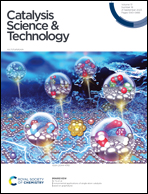Two-dimensional (2D) layered double metal cyanides as alternative catalysts for CO2/propylene oxide copolymerization†
Abstract
Although zinc–cobalt double metal cyanide (DMC) complex is a popular catalyst for the copolymerization of CO2 and epoxides, it faces important challenges, such as poor CO2 uptake, high cyclic carbonate formation, low ability to produce high-molecular-weight polymers, and an induction period. Therefore, the pursuit of alternative DMC complexes that can overcome these limitations has been a recurring research strategy in recent years. In this work, four novel 2D layered tetracyanonickelate complexes (M′[Ni(CN)4]; M′ = Ni2+, Co2+, Fe2+, Mn2+) were prepared, thoroughly characterized, and tested as catalysts for CO2 and propylene oxide copolymerization. These complexes yielded random polyethercarbonates (RPEC = 51–94%) with medium-to-low CO2 content (FCU = 13.1–42.4 mol%), moderate molecular weight (Mn = 11 000–36 500 g mol−1), and broad dispersity (Đ = 2.5–5.0). The Co–Ni DMC catalyst led to a 100% conversion of PO after 24 h, thus revealing itself as a possible alternative to the classic Zn–Co DMC compound. The catalytic performance of these compounds was compared in detail and their kinetics were assessed by in situ IR spectroscopy. While the Co–Ni DMC complex demonstrated remarkable selectivity, it requires further improvements in terms of activity and CO2 uptake to surpass its counterpart. Future research efforts should focus on driving these critical aspects.



 Please wait while we load your content...
Please wait while we load your content...